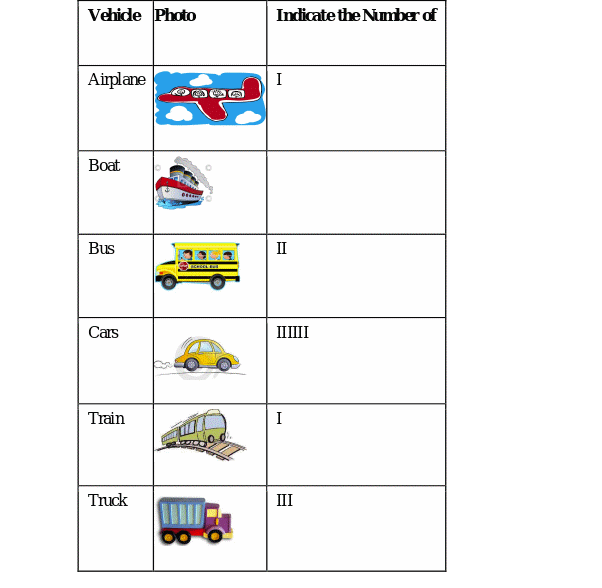Artifact 1. Data Collection Instrument
Description of the Artifact
The first artifact is a table for collecting data. The purpose of the artifact is to evaluate the learners’ grasp of the key concepts and tools of inquiry. It was meant for 5-year old children and was to engage the learners in an outdoor activity in subjects that focus on everyday life. Specifically, the learners were to visit a garage and fill the chart. They were to apply their numeracy skills in a practical environment, which not only provide opportunities for learning but also an interesting way to internalize knowledge.
Key Element
This artifact targets element 5a of the National Association for the Education of Young Children (NAEYC) code. It emphasizes on understanding essential content knowledge, especially in numeracy and mathematics. In addition, the artifact targets element 5b by evaluating the learners understating of the various inquiry tools and concepts (NAEYC, 2021). Lastly, it demonstrates the practical application of element 5c, which shows the instructor’s effective application of knowledge to design meaningful and challenging learning experiences for each child.
Demonstration of Competence
The artifact demonstrates the instructor’s competence in each of the three elements of the NAEYC standard. Firstly, it demonstrates the instructor’s content knowledge in mathematics and specifically in data collection. The learners familiarize themselves with data collection and classification, which is a key requirement for learning mathematics. Secondly, it demonstrates the knowledge and application of inquiry tools to solve problems. Lastly, it shows how instructors can apply their knowledge to develop meaningful and interesting learning opportunities for each learner. It shows that the instructor can use common tools and available resources to create strong foundation for acquisition of numeracy skills for the young learners in future.
Artifact

Artifact 2. Five Senses Fieldwork
Description of the Artifact
The second artifact was a chart for assessing the children’s appreciation of the five common senses. It was to be filled after a field tour within the school compound. In addition, the artifact targeted young learners aged below six years of age. Its main purpose was to develop self-awareness among the learners in a friendly and educative way.
Key Elements
This artifact focused on element 5a, which tests the instructor’s understanding of content knowledge in teaching young learners. Moreover, it tested the educator’s knowledge of key concepts and tools of inquiry needed to achieve effective learning as provided in element 5b. Lastly, the artifact tested the practical application of knowledge in designing meaningful and practical learning outcomes for the children.
Demonstration of Competence
The artifact demonstrates competence in each of the three elements in NAEYC standards. To begin with, it demonstrates the instructor’s awareness of content and resources by engaging the learners in age-appropriate self-discovery, which forms a critical part of early learning. Further, by engaging in field work, the artifact offers the children the tools needed to observe, experiment, question, and to ask questions that clarify their understanding of the personal senses. Lastly, the artifact and the practical field experience demonstrate the instructor’s effectiveness in developing an interactive session for learning the functions of common senses, their application, and their role in everyday life. Notably, the exposure to real-life experiences presents unforgettable learning opportunities and creates an interesting environment for learning and building social relationships. The relationships further strengthen the learners’ bonds and create effective teams for future learning.
Artifact
Reference
NAEYC professional preparation standards. (2021). NAEYC. Web.